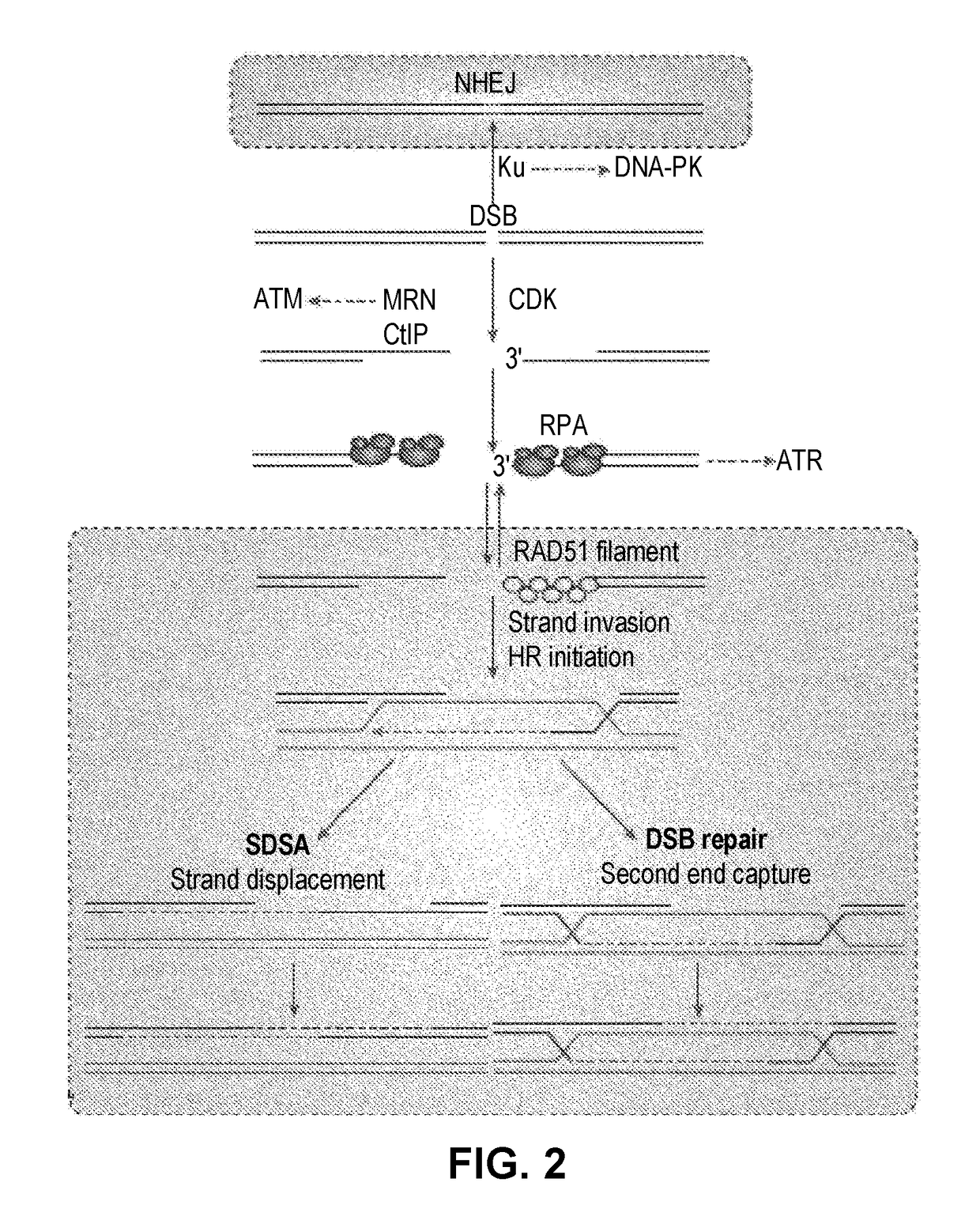Techniques for transfecting protoplasts
a technology of protoplasts and protoplasts, applied in the field of protoplast transfection technology, can solve the problems of unfavorable host characteristics, unfavorable transfection process, and inability to accurately control methods, so as to improve efficiency and control of the transfection process, the timing and efficiency of the introduction of foreign molecules can be enhanced, and the method is not very precise.
- Summary
- Abstract
- Description
- Claims
- Application Information
AI Technical Summary
Benefits of technology
Problems solved by technology
Method used
Image
Examples
examples
[0145]Plant Mismatch Repair Genes and Non-Homologous End Joining Genes
[0146]The public databases were screened for tobacco and tomato EST's sharing homology with genes involved in the MMR pathway (MSH2) and the NHEJ pathway (Ku70). The regions used to produce dsRNA are underlined. dsRNA was produced according to protocols well known in the art. In addition, a non-specific dsRNA species was generated derived from a plasmid which shows no significant homology with any of the genes of interest. This was used as a control to demonstrate that the presence of dsRNA per se is not responsible for suppression of specific mRNA's.
Tomato Ku70[SEQ ID NO 1]GGAAGATCTGAACGACCAGCTTAGGAAACGCATGTTTAAGAAGCGCAGAGTTCGAAGACTTCGACTTGTAATTTTTAATGGATTATCTATCGAACTTAACACCTATGCTTTGATCCGTCCAACTAATCCAGGGACAATTACTTGGCTTGATTCGATGACTAATCTTCCTTTGAAGACTGAGAGAACCTTCATATGTGCTGATACTGGTGCTATAGTTCAGGAGCCTCTAAAACGCTTTCAGTCTTACAAAGCGGCTTAAGCGTTTTGCAGTTGCTTTCTATGGGAATTTAAGTCATCCTCAATTGGTTGCTCTTGTTGCACAAGATGAAGTAATGACTCCTAGTGG...
example 2
Gene Targeting (Example 2)
[0152]For each transfection, 250000 protoplasts are mixed with 25 μg of double-stranded RNA against tomato Ku70, 20 μg of ZFN construct (Townsend et al. 2009 Nature) and 250 μL of PEG-Solution (40% PEG4000 (Fluka #81240), 0.1M Ca(NO3)2, 0.4M mannitol). Transfection is allowed to proceed for 20 minutes at room temperature. Five mL of 0.275M Ca(NO3)2 are added dropwise and thoroughly mixed in. Transfected protoplasts are harvested by centrifugation for 5 minutes at 85×g at room temperature and washed twice in CPW9M. Finally, protoplasts are re-suspended in K8p supplemented with 2 mg·L−1 dichlobenil and 2 mM hydroxyurea to a final density of 250000 per mL and incubate overnight at 25° C. in the dark. The next morning protoplasts are harvested by centrifugation at 85×g for 5 minutes at room temperature, washed once in CPW9M supplemented with 2 mM hydroxyurea and live protoplasts are isolated as described above. Live protoplasts are re-suspended in MaMg to a fin...
example 3
[0155]Plant Cell Lines
[0156]A tobacco Bright Yellow 2 cell suspension containing a non-functional EGFP gene was produced by introducing a point mutation in the chromophore region of the protein resulting in the formation of a premature stop codon. This line is used as reporter system to test the influence of various parameters on the repair of the EGFP gene by oligonucleotide-mediated targeted gene repair.
[SEQ ID NO 7]ATGGGAAGAGGATCGCATCACCACCATCATCATAAGCTTCCAAAGAAGAAGAGGAAGGTTCTCGAGATGGTGAGCAAGGGCTAGGAGCTGTTCACCGGGGTGGTGCCCATCCTGGTCGAGCTGGACGGCGACGTAAACGGCCACAAGTTCAGCGTGTCCGGCGAGGGCGAGGGCGATGCCACCTACGGCAAGCTGACCCTGAAGTTCATCTGCACCACCGGCAAGCTGCCCGTGCCCTGGCCCACCCTCGTGACCACCCTGACCTACGGCGTGCAGTGCTTCAGCCGCTACCCCGACCACATGAAGCAGCACGACTTCTTCAAGTCCGCCATGCCCGAAGGCTACGTCCAGGAGCGCACCATCTTCTTCAAGGACGACGGCAACTACAAGACCCGCGCCGAGGTGAAGTTCGAGGGCGACACCCTGGTGAACCGCATCGAGCTGAAGGGCATCGACTTCAAGGAGGACGGCAACATCCTGGGGCACAAGCTGGAGTACAACTACAACAGCCACAACGTCTATATCATGGCCGACAAGCAGAAGAACGGCATCAAGGTGAACTTCAAGATCCGCCA...
PUM
| Property | Measurement | Unit |
|---|---|---|
| time | aaaaa | aaaaa |
| time | aaaaa | aaaaa |
| time | aaaaa | aaaaa |
Abstract
Description
Claims
Application Information
 Login to View More
Login to View More - R&D
- Intellectual Property
- Life Sciences
- Materials
- Tech Scout
- Unparalleled Data Quality
- Higher Quality Content
- 60% Fewer Hallucinations
Browse by: Latest US Patents, China's latest patents, Technical Efficacy Thesaurus, Application Domain, Technology Topic, Popular Technical Reports.
© 2025 PatSnap. All rights reserved.Legal|Privacy policy|Modern Slavery Act Transparency Statement|Sitemap|About US| Contact US: help@patsnap.com



